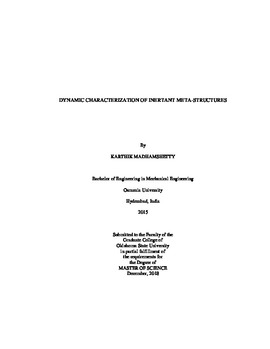| dc.description.abstract | In establishing the traditional analogies between mechanical and electrical networks, lack of preservation of topology while transitioning from a mechanical to its equivalent electrical network was rectified by so-called mobility or force-current analogy. One drawback was that the mass, which is the equivalent of the grounded capacitor, cannot represent a two-terminal device when described in an inertial frame. This was remedied by a two-terminal mechanical device termed the 'inerter' postulated at the turn of this century. The inerter is a mechanical element in which applied force is proportional to the relative acceleration across its terminals. The proportionality constant is termed 'inertance'. Practically, the inerter is realized by storing energy using a flywheel and can deliver a dynamic mass presence a few orders of magnitude greater than the device mass leading to considerable interest in inerters in recent years. In this study, inspired by acoustic metamaterials (AM), the dynamic characteristics of 'meta-structures' employing inerters are explored. Firstly, improved analytical models incorporating component inertias and sizing and parametric studies for two prominent embodiments of the inerter viz. the rack-and-pinion and the ball-screw inerter are considered. The dependence of specific inertance (ratio of inertance to static mass) on key parameters are brought out through simulations. A prototype rack-and-pinion inerter with specific inertance of 90 was designed, fabricated and tested under low-rate excitations. Measured specific inertance was found to display an exponential decline with increase in excitation frequency. Using a phase-matching procedure, estimation of internal stiffness and damping in the prototype reveals influences of the excitation frequency and ultra-low frequency meandering effects. Further, motivated by challenges in miniaturizing rotary components for microscale inerters, a potential kinematically-simpler structure based on the von Mises truss is investigated. Its nonlinear equation of motion is derived using Hamilton's principle. Potential inertant mechanisms for this structure under harmonic inputs are probed using simulations. Finally, while studies on inherent nonlinearities in inerters are more widely available, those concerning the use of intentionally nonlinear inerters are scarce. In this context, the mechanical wave manipulation characteristics of Nonlinear Inertant Acoustic Metamaterials (NLIAM) are studied. Based on notional concepts for inertant devices, frequency and acceleration-dependent nonlinear inertant models are advanced. Dispersion characteristics of NLIAM with frequency-dependent inverse square law (ISL) and power law (PL) inertance are examined. While a tuned ISL model ensures existence of band gap over almost the entire bandwidth of interest, its limiting inertances are challenging to realize in practice. A potentially more practical PL approximation is proposed and shown to have a widening of the band gap by more than 100% towards frequencies below the lower bound of the band gap for the AM with frequency invariant inertance. Further, drawing inspiration from the Duffing-type stiffness, first order dispersion corrections are obtained for an NLIAM with acceleration-dependent inertance using a perturbation approach. Dispersion curves shifts are found to enable this NLIAM to act as a passive adaptive filter for mechanical waves based solely on excitation amplitude. Practical manifestations of NLIAM could help realize extraordinary wave manipulation capabilities especially suitable for low frequency structural dynamic applications. | |
